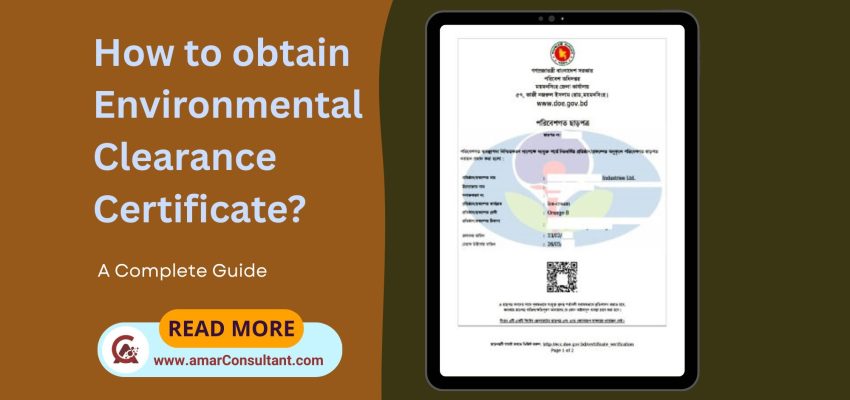
How to Obtain an Environment Clearance License in Bangladesh?
In Bangladesh, obtaining an Environment Clearance Certificate (ECC) is a mandatory step for initiating any industrial or development project. This certificate ensures that your project or industry meets the necessary environmental standards and mitigates potential negative impacts. The Department of Environment (DoE) is the governing body responsible for issuing these certificates.
🌿What is Environmental Clearance Certificate (ECC)?
An Environmental Clearance Certificate in Bangladesh is a legal permit issued by the Department of the Environment (DOE) Bangladesh. The purpose of this license is to regulate and control the environmental impact of industrial, commercial, and other activities that could have a negative impact on the environment.
🏭Who needs to obtain an Environment Clearance Certificate (ECC)?
Environmental clearance is compulsory for each and every form of industry and project as provided in the Bangladesh Environmental Conservation Act, 1995. No industrial establishment can be undertaken without obtaining an Environmental Clearance Certificate (ECC) from the Department of the Environment (DOE). The industry or project must meet all specified requirements set by the Government of Bangladesh regarding air, noise, water, odor, and other environmental quality standards. These requirements supplement those in the Factories Act 1965, which regulates the internal atmosphere of factories and industries.
⚖️Why needs to obtain an Environment Clearance Certificate (ECC)?
Securing an Environment Clearance Certificate is a vital step in ensuring that your project complies with Bangladesh’s environmental regulations. By following the outlined procedures and maintaining transparency, you contribute to sustainable development and environmental conservation.
🔍Understand the Project Category
The first step is to identify the category of your project, which is determined by its location and potential environmental impact. The four categories are:
- Green: Projects with minimal environmental impact.
- Orange A: Projects with a minor environmental impact.
- Orange B: Projects with a moderately significant environmental impact, which requires Environmental Impact Assessment (EIA).
- Red: Projects with a high environmental impact, Which requires Environmental Impact Assessment (EIA) and Location Clearance Certificate (LCC).
📌Determining the correct category is crucial as it dictates the documentation and procedures required.
📑Prepare Required Documents
Depending on the project category, the following documents are typically required:
- Completed application form (Form-3)
- Project layout and location maps
- Trade License
- Tax Identification Number (TIN)
- Value Added Tax (VAT) registration
- No Objection Certificate (NOC) from local authorities
- Bank solvency certificate
- Environmental Management Plan (EMP)
- EIA or Initial Environmental Examination (IEE) report (for Orange-B and Red categories)
📌Additional documents may be required based on the specific nature of the project.
📤Application Process
- Submit Application to the DoE: Applications can be submitted online through the DoE’s official portal or directly to the relevant DoE office based on the project’s location. Ensure all documents are complete and accurate to avoid delays and pay required fees.
- Document Verification: Upon submission, the DoE will verify the application and supporting documents. For projects in the Orange-B and Red categories, an inspection by an authorized officer will be conducted.
- Site Inspection: A DOE inspection officer will visit the project site for a further inspection. This step ensures that the project complies with environmental standards
- Committee Meeting (Orange B & Red): For Orange-B and Red category projects, a meeting will be convened by the Environmental Clearance Committee to assess the project’s environmental impact and compliance.
- Certificate Issuance: If the DOE is satisfied with the application and inspection results, they will issue the certificate. The validity period of the certificate varies:
- Green Category: Valid for 3 years
- Orange-A, Orange-B, and Red Categories: Valid for 1 year
🏷️ Government Fees
The government fees for the ECC are based on the total investment of the project, ranging from BDT 3,000 to BDT 15,00,000. For example, a project with an investment BDT 20 crore to 50 crore could have an estimated fee of BDT 160,000. The average processing time is between 1 to 5 months.
🔄Certificate Renewal and Fees
Certificate Renewal and Fees
Renewal applications should be submitted at least 30 days before the expiry date. Renewal fees for the ECC are also based on the total investment of the project amounting to 50% of Certificate Fees.
For more detailed information and guidance, visit the Department of Environment’s official website or consult with an expert professional consultants familiar with the DOE Certification process in Bangladesh
Author:
👨💼Gias Uddin CAP, ITP
🛡️Professional Accountant, Income Tax Lawyer
📲01734-008136 (WhatsApp)

An ECC is a permit issued by the Department of Environment (DoE) that allows a project or industrial operation to start, after demonstrating that it will meet environmental standards (air, water, noise, waste etc.) under the Bangladesh Environment Conservation Act.
Any industry, project, or activity that may have environmental impact (pollution, discharges, noise, etc.), such as factories, construction works, manufacturing, etc., must apply for ECC before.
Projects are grouped into categories (Green, Orange-A, Orange-B, Red) based on their potential environmental impact. The stricter the category (up to Red), the more extensive the assessment and requirements.
Green category: basic information, NOC from local authority; no EIA/IEE needed.
Orange-A: moderate documentation including layout plans, process flow, etc.
Orange-B: Initial Environmental Examination (IEE), Environmental Management Plan (EMP) etc.
Red: full Environmental Impact Assessment (EIA) report, detailed mitigation plans, emergency response etc.
